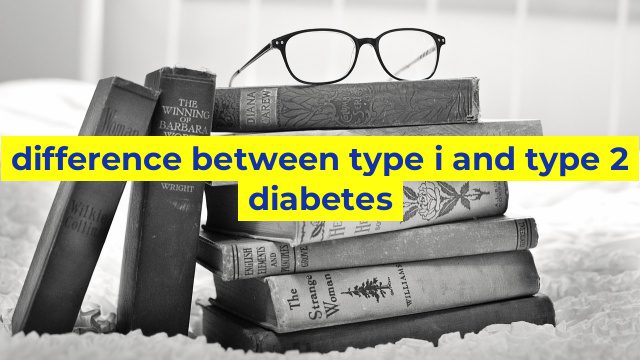Difference between Type I and Type II Diabetes
Diabetes is a common metabolic disorder that affects millions of people around the world. This disease is characterized by high levels of sugar (glucose) in the blood due to insufficient insulin production, resistance to insulin, or both. There are two main types of diabetes – type I and type II. Although both types share some similarities, they have distinct differences in terms of their causes, symptoms, and treatment.
Causes
Type I diabetes, also known as juvenile diabetes or insulin-dependent diabetes, is an autoimmune disease that occurs when the immune system attacks the cells in the pancreas that produce insulin. This results in a lack of insulin production in the body, which leads to high blood sugar levels. The exact cause of type I diabetes is not known, but genetic and environmental factors are thought to play a role.
Type II diabetes, also called adult-onset diabetes or non-insulin-dependent diabetes, is usually caused by a combination of genetic and lifestyle factors. In this type of diabetes, the cells become resistant to insulin, which means that the body cannot use insulin effectively to control blood sugar levels. Over time, the pancreas may also produce less insulin, adding to the problem.
Symptoms
The symptoms of type I and type II diabetes can be similar, but there are some differences. In type I diabetes, symptoms tend to develop rapidly and can be severe. They may include increased thirst, frequent urination, weight loss, fatigue, blurred vision, and slow healing of wounds. On the other hand, type II diabetes symptoms may develop slowly over time and may not be noticeable for many years. Some people with type II diabetes may not experience any symptoms, while others may have symptoms such as increased thirst, frequent urination, blurred vision, and slow healing of wounds.
Treatment
The treatment for type I and type II diabetes varies depending on the type and severity of the disease. Type I diabetes needs lifelong insulin therapy, which involves injecting insulin into the body to regulate blood sugar levels. In contrast, people with type II diabetes may be able to manage their condition through a combination of lifestyle modifications and oral medications. These may include taking medications that increase insulin sensitivity or stimulate insulin production, adopting a healthy diet, exercising regularly, and losing weight.
In conclusion, while both type I and type II diabetes share similarities, they have distinct differences in terms of their causes, symptoms, and treatment. Understanding these differences can help individuals with diabetes receive the appropriate and personalized care they need to manage their condition and live a healthy life.
Table difference between type i and type 2 diabetes
Type 1 vs Type 2 Diabetes
| Type 1 Diabetes | Type 2 Diabetes | |
|---|---|---|
| Description | Autoimmune disease where the immune system attacks and destroys insulin-producing cells in the pancreas | Metabolic disorder where the body does not use insulin properly or does not produce enough insulin |
| Cause | Genetic and environmental factors | Poor lifestyle habits and genetic factors |
| Symptoms | Increased thirst, frequent urination, extreme hunger, unexplained weight loss, blurry vision, fatigue, mood changes | Frequent urination, increased thirst, hunger, fatigue, blurred vision, slow healing sores or frequent infections, tingling or numbness in hands or feet |
| Treatment | Insulin therapy, blood sugar monitoring, healthy eating, regular exercise | Healthy eating, regular exercise, maintaining a healthy weight, blood sugar monitoring, medication (oral and/or injectable) |
| Age at Diagnosis | Usually diagnosed in childhood or adolescence | Usually diagnosed in adulthood |
| Prevalence | 5-10% of all cases of diabetes | 90-95% of all cases of diabetes |

